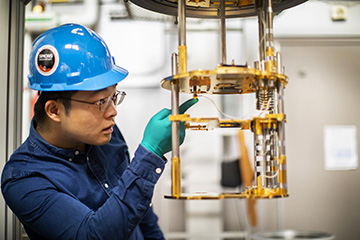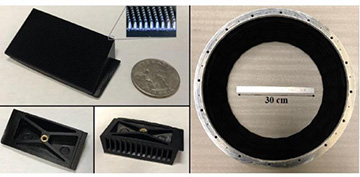
Thermal testing of the new metamaterial tiles in an advanced cryogenic facility showed that they could be effectively cooled to the cryogenic temperatures necessary. [Image: Eric Sucar, Penn Today]
Tiles coated with metamaterials that strongly absorb microwave radiation will play a key role in the next big ground-based observatory dedicated to studying the cosmic microwave background (CMB), the faint afterglow of the universe’s origin (Appl. Opt., doi: 10.1364/AO.411711).
The tiles—made from carbon-loaded polyurethane—absorb more than 99% of incident radiation in the millimeter wave band and can withstand the cryogenic temperatures needed for instruments to pick up the cosmic noise. These tiles will line the large-aperture (6 m) telescope and three small-aperture (0.5 m) telescopes that will constitute the Simons Observatory, now under construction 5200 m above sea level in the Atacama Desert in northern Chile.
Ground-based telescopes and the CMB
Scientists know of the existence of the cosmic microwave background only because of ground-based millimeter-wave receivers. In 1965, two researchers from Bell Laboratories, USA, were trying to reduce extraneous, nearly isotropic noise from a cryogenically cooled horn-shaped antenna, but they could not eliminate it entirely. By combining their observations with theoretical models from scientists at Princeton University, USA, they realized that they had picked up the oldest radiation in the universe.
Over the last half-century, cosmologists have studied the CMB with balloon- and space-based observatories, but ground-based telescopes, with larger apertures and arrays than receivers designed to be launched, still have an important role to play in cosmological research.
Metamaterials as baffles

The top left photo shows one tile, with its antireflective surface shown in the insert. The bottom left photos show the back of the tile, and the right photo shows the assembly of 240 tiles installed on the wall of an optics tube. [Image: Zhilei Xu, University of Pennsylvania ]
Stray light can compromise image quality in any telescope, but for the Simons instruments the methods of suppressing stray radiation must be tailored to the operating frequency band from 90 GHz to 270 GHz and operating temperatures around 100 mK.
The research team, led by University of Pennsylvania, USA, postdoctoral fellow Zhilei Xu, rejected existing epoxy and absorptive sheeting materials because of high-mass and thermal cycling issues. Instead, they designed tiles covered with tiny pyramidal structures, each 1.5 mm high and 0.6 mm wide (subwavelength scale in this application). The absorbing surface—the tile side that contains the pyramids—is inclined at a 26-degree angle to the inside of the optical tube of the telescope.
After testing several types of carbon-loaded plastics, the scientists chose to make the tiles out of polyurethane containing 25% carbon by mass. (A higher carbon fraction would have made the tiles too breakable.) Fabricating the tiles by standard injection molding has the added benefit of dropping the cost of production by 90%.
Room-temperature laboratory tests showed that the metamaterial tile surfaces have a reflectance of less than 1% and wide-angle scattering below 0.01% at microwave wavelengths. (The tiles look extremely black and nonreflective even under visible lighting.) Also in the lab, the researchers cooled a tile down to 1 K with a single thermal contact.
Array under construction
The one large and three small receivers that will constitute the Simons Observatory are scheduled to see first light around 2022. The researchers say their tiles will make up a modularized antireflective surface that can be easily fixed in case of minor damage.
More than 250 scientists belong to the collaboration that is building the Simons Observatory. The coauthors of the metamaterial tiles study included researchers from 11 U.S. institutions as well as universities in Japan, Italy and Sweden.
